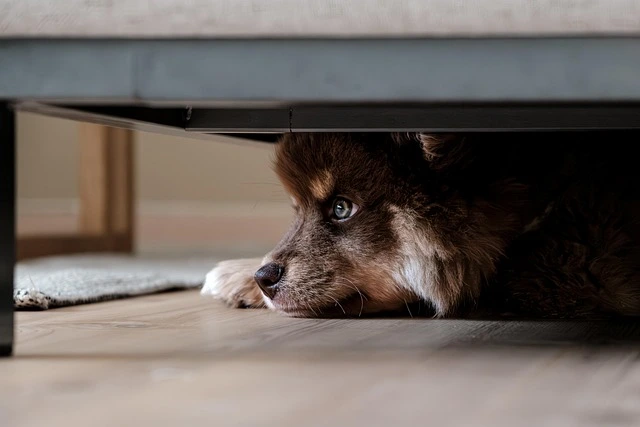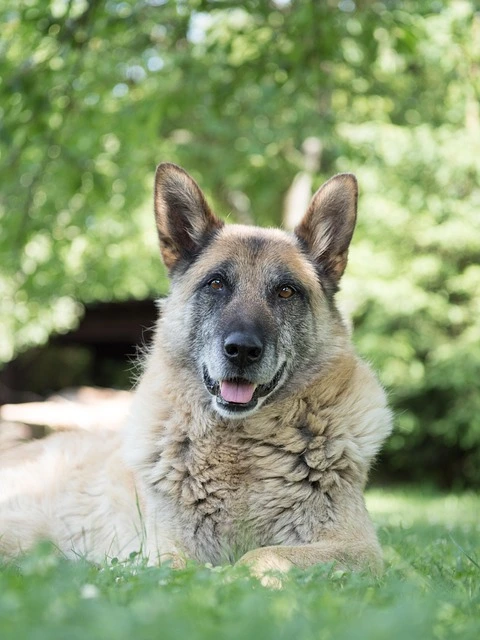Does your dog tremble at every thunderclap, panic when you leave the house, or shy away from strangers? You’re not alone—millions of dogs experience anxiety every day, and many owners struggle to know how to help. That’s why we created this Dog Anxiety Expert Guide 2025 update—a clear, vet-informed resource packed with the latest research, calming techniques, and practical strategies to bring your anxious pup relief. From natural remedies to proven training methods, you’ll learn how to recognize the signs of stress, support your dog’s emotional well-being, and build a calmer, happier life together.

Table of Contents
Understanding Dog Anxiety: A Growing Concern for Pet Parents
Does your dog pace nervously when you grab your keys? Do thunderstorms send them hiding under the bed? Your furry friend might be experiencing anxiety, a condition that affects an astonishing 72.5% of dogs according to recent scientific research. Dog anxiety isn’t just an occasional worry—it’s a serious condition that can significantly impact your pet’s quality of life and even shorten their lifespan if left untreated. If your dog experiences anxiety while in the car, check our guide on dog travel anxiety to explore Prevention & Management Tips for Stress-Free Car Rides.
In this comprehensive guide, we’ll explore everything you need to know about dog anxiety—from recognizing the subtle signs to implementing effective treatment strategies. Whether your dog struggles with separation anxiety, noise phobias, or general fearfulness, you’ll find practical solutions based on the latest veterinary research and behavioral science.
What Is Dog Anxiety? Understanding Your Pet’s Emotional Health
Dog anxiety is a state of distress or fear that goes beyond normal cautious behavior. While it’s natural for dogs to be wary of potential threats, anxiety becomes problematic when it’s excessive, persistent, or triggered by everyday situations that shouldn’t cause distress.
Just like humans, dogs can experience various types of anxiety that manifest in different ways. Understanding these distinctions is crucial for proper diagnosis and treatment.
Types of Dog Anxiety
Separation Anxiety in Dogs
Separation anxiety occurs when dogs become extremely distressed when left alone or separated from their owners. This form of anxiety has seen a dramatic rise in recent years, with studies showing an alarming 760% increase since 2020—likely exacerbated by the pandemic and changing work patterns.
Dogs with separation anxiety typically show signs of distress within minutes of their owner’s departure. They may engage in destructive behaviors, have indoor accidents despite being house-trained, or vocalize excessively (barking, howling, whining).
Fear-Related Anxiety
Fear-related anxiety can be triggered by specific stimuli such as:
- Loud noises (fireworks, thunderstorms, vacuum cleaners)
- Unfamiliar people or animals
- New environments or situations
- Visual stimuli (umbrellas, hats, reflective surfaces)
- Specific surfaces (grass, wood floors, grates)
Research indicates that noise sensitivity is particularly common, affecting approximately 32% of dogs, with fireworks being the leading trigger.
Social Anxiety
Some dogs experience anxiety in social situations, especially around unfamiliar dogs or people. This can manifest as fear-aggression, avoidance, or extreme nervousness in social settings. Studies show that around 17% of dogs are fearful of other dogs, while about 15% are afraid of strangers.
Generalized Anxiety
Dogs with generalized anxiety appear perpetually on edge, even without obvious triggers. They may struggle to relax in any environment and exhibit chronic anxiety symptoms regardless of the situation.
Dog Anxiety Symptoms: How to Recognize When Your Dog Is Stressed
Identifying anxiety in dogs requires careful observation, as many signs can be subtle or mistaken for other issues. Here are the key symptoms to watch for:
Physical Symptoms of Dog Anxiety
- Panting (when not hot or after exercise)
- Trembling or shaking
- Excessive drooling
- Increased heart rate
- Dilated pupils
- Excessive shedding
- Changes in body posture (tail tucked, ears back, crouched position)
- Excessive yawning (when not tired)
- Pacing or inability to settle
Behavioral Symptoms of Dog Anxiety
- Destructive behavior (especially around exit points like doors and windows)
- Inappropriate urination or defecation (despite being house-trained)
- Excessive vocalization (barking, whining, howling)
- Excessive licking or chewing (can lead to hot spots or acral lick dermatitis)
- Escape attempts (which can lead to injury)
- Aggression (toward people, other animals, or when someone approaches a resource)
- Hiding or seeking constant reassurance
- Compulsive behaviors (tail chasing, pacing in patterns, excessive self-grooming)
- Decreased appetite or refusal to eat
One of the most common manifestations of anxiety-driven compulsive behavior is persistent paw licking, which can quickly escalate from a self-soothing mechanism into a medical concern requiring both behavioral and physical intervention.
It’s important to note that nearly half of all dog owners report observing barking and hyperactivity repeatedly (weekly or more frequently), with some noticing these behaviors multiple times daily.
Causes of Dog Anxiety: What’s Behind Your Dog’s Stress?
Understanding what causes anxiety in dogs can help you address the root of the problem rather than just managing symptoms. Let’s explore the main contributors:
Genetic Predisposition
Research indicates a strong genetic component to anxiety in dogs. A landmark study published in Scientific Reports found that certain anxieties clustered in specific breeds:
- Noise sensitivity was most common in Lagotto Romagnolos, wheaten terriers, and mixed-breed dogs
- Fearfulness was highest in Spanish water dogs, Shetland dogs, and mixed breeds
- Aggression toward strangers was notably prevalent in miniature schnauzers
This genetic link suggests that by selecting for certain traits (like sociability), humans may have unintentionally selected for increased sensitivity in other areas.
Early Life Experiences and Socialization
Inadequate socialization during the critical developmental period (3-14 weeks) can significantly increase a dog’s risk of developing anxiety. Puppies need positive exposure to various people, animals, environments, and stimuli during this window to develop confidence and resilience.
Traumatic experiences, especially during developmental stages, can leave lasting impressions. Dogs who have experienced abuse, neglect, or frightening events may develop anxiety as a result.
Health Issues
Underlying medical conditions can cause or exacerbate anxiety symptoms. Pain, thyroid disorders, neurological problems, and sensory decline (especially in senior dogs) can all contribute to increased anxiety.
Environmental Factors
Significant changes in a dog’s environment or routine can trigger anxiety. This includes:
- Moving to a new home
- Addition of new family members (human or animal)
- Loss of a family member
- Changes in the owner’s schedule
- Environmental stressors (construction noise, new neighbors)
The pandemic created a perfect storm for canine anxiety, with dramatic shifts in human schedules and routines followed by returns to pre-pandemic lifestyles leaving many dogs struggling to adjust.
Dog Anxiety Treatment: Effective Solutions for Your Anxious Pet
Treating dog anxiety typically requires a multi-faceted approach tailored to your dog’s specific needs. Here are the most effective treatment strategies:
Behavioral Training Approaches
Counterconditioning
This technique aims to change your dog’s emotional response to anxiety triggers by creating positive associations. For example, if your dog fears strangers, you would pair the presence of strangers with high-value treats or fun activities, gradually helping your dog associate strangers with positive experiences rather than fear.
Desensitization
Desensitization involves gradually exposing your dog to the anxiety trigger at an intensity that doesn’t provoke fear, then slowly increasing the intensity over time. For noise phobias, this might mean playing recordings of thunder at a very low volume while your dog is relaxed, then gradually increasing the volume as your dog becomes comfortable.
Systematic Relaxation Training
Teaching your dog to relax on cue can help them cope with stressful situations. This involves rewarding calm behavior and practicing relaxation exercises regularly so your dog can call upon these skills when faced with triggers.
Environmental Management
Creating a safe, predictable environment can significantly reduce anxiety:
- Safe spaces: Designate a comfortable area where your dog can retreat when stressed. This might include a crate with comfortable bedding, a quiet room, or a covered area.
- Routine and predictability: Maintain consistent schedules for feeding, walks, play, and sleep.
- Exercise and mental stimulation: Regular physical activity and mental enrichment can help reduce overall anxiety levels by releasing excess energy and stimulating the brain.
- Calming environmental modifications: White noise machines, calming music designed for dogs, and pheromone diffusers can create a more soothing atmosphere.
Natural Remedies for Dog Anxiety
Many pet owners prefer to start with natural approaches before considering medication:
Supplements and Natural Calming Aids
- L-theanine: An amino acid found in tea that has calming properties
- Zylkene: Contains a milk protein with natural calming effects
- CBD oil: Some dog owners report success with CBD for anxiety, though research is still developing
- Valerian and chamomile: Herbs with natural sedative properties
- Melatonin: May help with sleep disturbances and some anxiety symptoms
Physical Calming Tools
- Pressure wraps and anxiety vests: Products like the Thundershirt apply gentle, constant pressure that has a calming effect on many dogs.
- Calming caps: Reduce visual stimulation for dogs triggered by what they see
- Anxiety wraps: Similar to pressure wraps but may cover different areas of the body
Prescription Medications for Dog Anxiety
For severe anxiety cases, medication prescribed by a veterinarian may be necessary:
For Situational Anxiety (Predictable Events)
- Benzodiazepines like diazepam (Valium) for short-term use during predictable stressful events
- Trazodone for event-specific anxiety
- Sileo (dexmedetomidine oromucosal gel), specifically approved for noise aversion
For Chronic Anxiety
- SSRIs like fluoxetine (Prozac) or sertraline (Zoloft)
- TCAs like clomipramine (Clomicalm)
- Buspirone for generalized anxiety
It’s important to note that medication works best when combined with behavioral strategies and should be prescribed and monitored by a veterinarian.
Our Top 3 Picks for Calming Your Anxious Dog
- ThunderShirt Classic Anxiety & Calming Vest
- VetriScience Calm & Confident Chews
- Vetoquinol Zylkene Calming Support
For additional expert insights into dog anxiety symptoms and treatment approaches, you can also explore the AKC’s guide on treating dog anxiety.
Preventing Dog Anxiety: Proactive Strategies for a Confident Canine
While not all anxiety can be prevented, these proactive measures can reduce the risk:
Proper Socialization
Expose puppies to a wide variety of people, animals, environments, and stimuli during their critical socialization period (3-14 weeks). Ensure these experiences are positive and not overwhelming.
Positive Training Methods
Use reward-based training methods that build confidence rather than punishment-based approaches that can increase fear and anxiety.
Gradual Exposure to Being Alone
Help puppies learn that being alone is normal and safe by practicing brief separations from an early age, gradually increasing duration.
Regular Exercise and Mental Stimulation
Provide appropriate physical exercise and mental enrichment daily to prevent boredom and reduce stress.
Maintaining Health and Wellness
Regular veterinary check-ups can catch and address health issues that might contribute to anxiety before they become serious.
When to Seek Professional Help for Dog Anxiety
While mild anxiety can often be managed at home, you should consult a professional if:
- Your dog’s anxiety is severe or worsening
- Anxiety is affecting your dog’s quality of life or your relationship
- Your dog shows aggressive behavior
- Home management strategies aren’t working
- You suspect a medical issue may be contributing to anxiety
Depending on the severity, you might consult:
- Your primary veterinarian
- A veterinary behaviorist (DACVB)
- A certified applied animal behaviorist (CAAB)
- A certified professional dog trainer (CPDT) with experience in anxiety
Living with an Anxious Dog: Support and Coping Strategies
Living with an anxious dog requires patience, understanding, and consistent management:
Support for Your Dog
- Maintain predictable routines
- Recognize and respect your dog’s boundaries
- Create multiple safe spaces throughout your home
- Use positive reinforcement for confident behaviors
- Stay calm during your dog’s anxiety episodes
- Continue training and socialization at your dog’s pace
- Consider how your own emotions might affect your dog
Support for You
Caring for an anxious dog can be emotionally taxing. Remember to:
- Set realistic expectations for progress
- Celebrate small improvements
- Connect with support groups of owners with anxious dogs
- Take breaks when needed
- Consider professional support if your dog’s anxiety is affecting your wellbeing
Conclusion: Hope for Dogs with Anxiety
Dog anxiety is a complex condition, but with patience, consistency, and the right approach, most anxious dogs can experience significant improvement. The key is to:
- Accurately identify your dog’s specific anxiety type and triggers
- Consult with professionals to develop a tailored treatment plan
- Implement a multi-modal approach combining behavioral, environmental, and possibly medical interventions
- Remain patient and consistent, recognizing that progress may be gradual
By understanding your dog’s anxiety and taking proactive steps to address it, you’re not just improving their quality of life—you’re strengthening your bond and potentially extending their lifespan. Remember that helping an anxious dog isn’t a sprint but a marathon, with small victories along the way that build toward lasting improvement.
Frequently Asked Questions
Can dogs develop anxiety suddenly?
While anxiety often develops gradually, sudden onset can occur after traumatic events or with certain medical conditions. If your dog suddenly develops anxiety symptoms, consult your veterinarian to rule out medical causes.
Are certain breeds more prone to anxiety?
Yes, research suggests some breeds have higher genetic predispositions to anxiety. Herding breeds often show more sensitivity to noise, while some small breeds may be more prone to separation anxiety. However, any dog regardless of breed can develop anxiety.
Can I use human anxiety medications for my dog?
Never give human medications without veterinary guidance. While some human anxiety medications are used in dogs, the dosages and metabolism differ significantly, and some human medications are toxic to dogs.
How long does it take to see improvement in dog anxiety?
Timeline varies based on the severity, type of anxiety, and treatment approach. Some dogs show improvement within weeks, while others may need months of consistent work. Severe cases may require ongoing management throughout life.
Will my dog outgrow anxiety?
Puppies may outgrow mild fears with proper socialization, but established anxiety disorders typically don’t resolve without intervention. Early treatment yields the best results.
Can anxiety in dogs lead to health problems?
Yes, chronic anxiety can lead to suppressed immune function, digestive issues, skin problems, and may shorten lifespan. A study in the Journal of Veterinary Behavior found that dogs with fear and anxiety disorders have increased disease frequency.
Is medication always necessary for dog anxiety?
No, mild to moderate anxiety can often be managed with behavioral and environmental strategies alone. Severe cases may benefit from medication alongside other approaches.
Can diet affect my dog’s anxiety levels?
Some evidence suggests that certain nutrients can affect brain function and potentially anxiety levels. Diets rich in omega-3 fatty acids, antioxidants, and B-vitamins may support brain health and potentially help manage anxiety.

